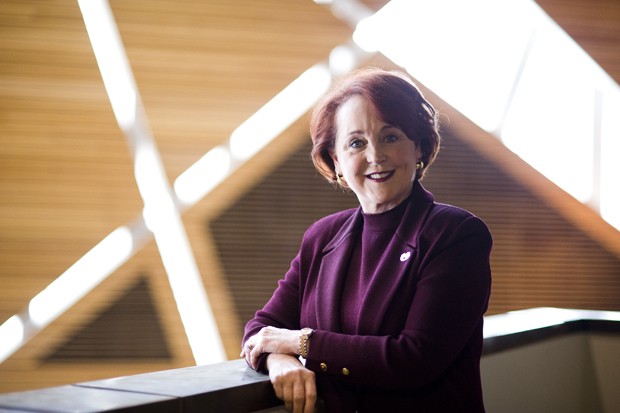For two University of Minnesota classes, field trips are to corporate offices and homework is taking care of more than $10 million of someone elseâÄôs money. Serving as analysts, managers and strategists, 28 Carlson School of Management students manage two funds that have weathered the recession stronger than their stock market counterparts. The Carlson Funds Enterprise (CFE) is made up of a $12.5 million growth fund and a $16.3 million fixed-income fund. Formally titled MBA 6501 and 6502, the classes each meet twice a week. But the majority of the work for the funds management is done outside of class. âÄúItâÄôs a lot of work, without a doubt,âÄù said Michael Waterhouse, managing director for the growth fund and a Master of Business Administration graduate student. Waterhouse came to the University specifically because of the program. Students working with the CFE growth fund manage existing funds and examine market trends, along with ebbs and flows in researching potential in stocks for investing. This fund was valued at $12.5 million as of December 2009, said CFE director Joe Barsky. The fund was established with $3.5 million in 1998. The less-risky CFE fixed-income fund, or bond fund, was started in 2003 and has since grown from $11 million to $16.3 million. While company analyses break down differently for the growth fund than for the fixed-income fund, fixed-income fund managing director Leslie Olson said all the students are basically âÄúlooking for good companiesâÄù to invest in. Smart stock and bond picks account for the majority of the growth for both funds, but additional donations âÄî since the seed money âÄî from companies also contribute to the growth, Barsky said. Most local companies that have invested in the project did so in hopes of recruiting the University students later on, Barsky said. Thrivent Financial for Lutherans invested $2 million in the growth fund in 2008. The Minneapolis-based Fortune 500 financial services company has a history of hiring Carlson graduates. One such hire was Mark Simenstad, who graduated from the MBA program in 1983 and is now ThriventâÄôs vice president of fixed-income mutual funds. âÄúWeâÄôve been pleased with the results, but more importantly itâÄôs provided good, real-world experience for students over at the U,âÄù said Simenstad, who has also mentored with the program since 2003. The class itself is graded qualitatively, without exams, Waterhouse said. The real test for these students is the culmination of their work since last summer, when the students started the course. After spending the last year analyzing, researching and consulting with companies, each student or small group of students has the chance to pitch one stock they think would be beneficial to invest in to an oversight committee, which must approve the choice by vote. Waterhouse described a boardroom experience reminiscent of Donald TrumpâÄôs âÄúApprenticeâÄù style. Each pitch lasts about 20 minutes, followed by a âÄúpeppering of questionsâÄù from the mentors, said Waterhouse. âÄúItâÄôs a little stressful, because the questions are tough,âÄù he said. âÄúYou definitely have to know what youâÄôre talking about.âÄù These judges double as industry mentors for the students. Vitali Datsenko, a fixed-income fund mentor, said he looks more for stable funds than for a fancy presentation in the studentsâÄô pitches. Datsenko, who does similar portfolio management work at the University, said this real-life experience is the right kind of exposure and responsibility for the business students. âÄúItâÄôs a lot of money, and I think they treat it as such,âÄù he said. Companies invested in the funds âÄî among them Wells Fargo and U.S. Bancorp âÄî are confident in the studentsâÄô abilities, Datsenko said. Growth fund market analyst and Carlson undergraduate Ben Gaither said he has met with CFOs and other corporate chiefs through the program, allowing him to âÄúreally get [his] hands on the pulse of what the companyâÄôs doing.âÄù The recession has made the experience more difficult than years past. The hardest part of the course is âÄútrying to predict the future,âÄù he said. âÄúItâÄôs actually been very interesting, given the economic cycle thatâÄôs been going on at the same time,âÄù Gaither said. âÄúItâÄôs more of an art than a science.âÄù âÄúThings that were assumed in the past are no longer assumptions for the future,âÄù Olson said. Datsenko said he has been voting against most stock pitches lately due to this turbulent economic climate. Nevertheless, the studentsâÄô funds have outperformed their marketplace counterparts over the past five years. The funds combine to make the UniversityâÄôs enterprise the second largest student-run investment portfolio in the United States, Barsky said. It is topped only by the Applied Security Analysis Program at the University of Wisconsin-Madison School of Business. However, Barsky said the majority of WisconsinâÄôs $60 million fund comes from university endowment. CarlsonâÄôs program is âÄúcompletely separate from the University,âÄù which makes the course more of a challenge, Barsky said. Exemplifying the enterpriseâÄôs success, Barsky said $10,000 invested in the growth fund in 1998 is valued at $27,300 today. âÄúWeâÄôve proved to be pretty good researchers,âÄù Gaither said. âÄúSometimes itâÄôs dumb luck, and sometimes we actually know what weâÄôre doing.âÄù

Image by Aleutian Calabay
High-stakes homework: Managing $28.8 million
Two Carlson classes allow MBA students to handle investment funds.
Published February 1, 2010
0

